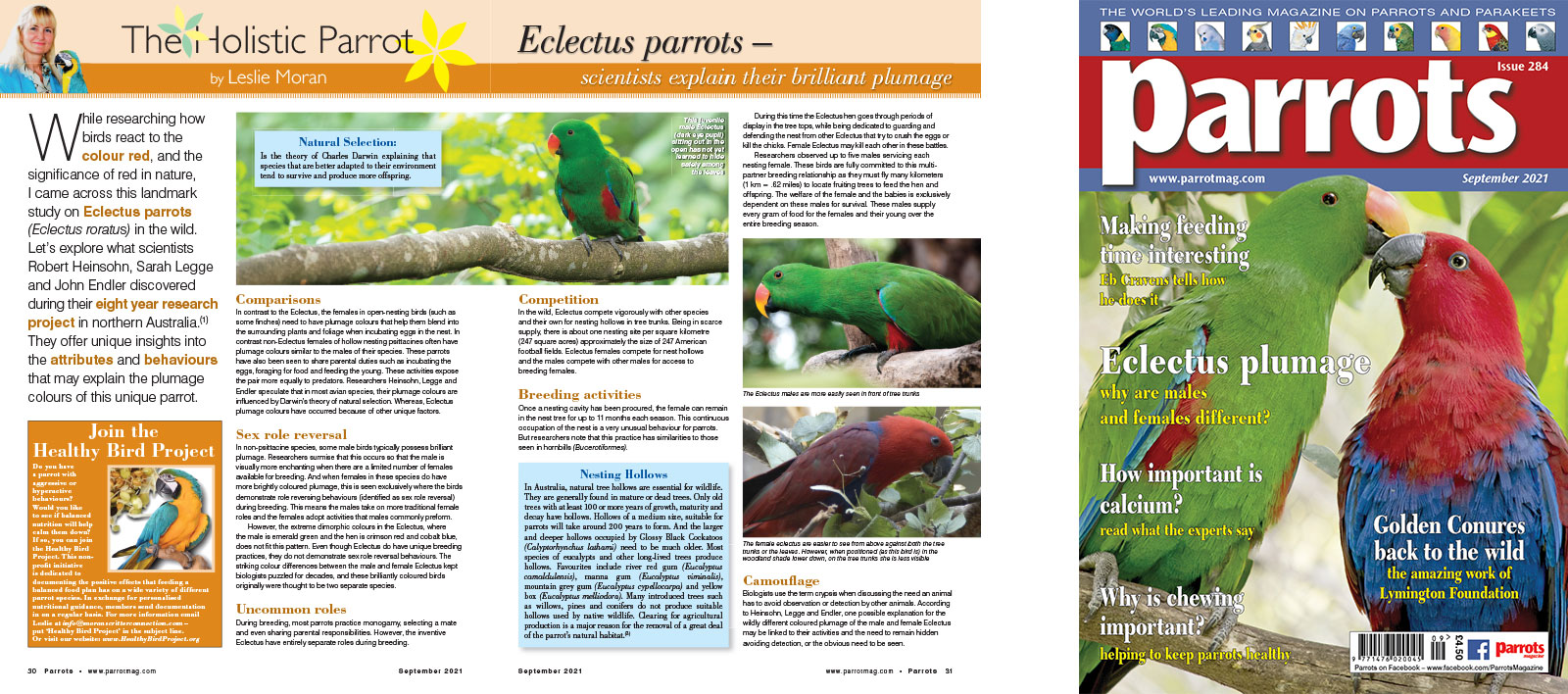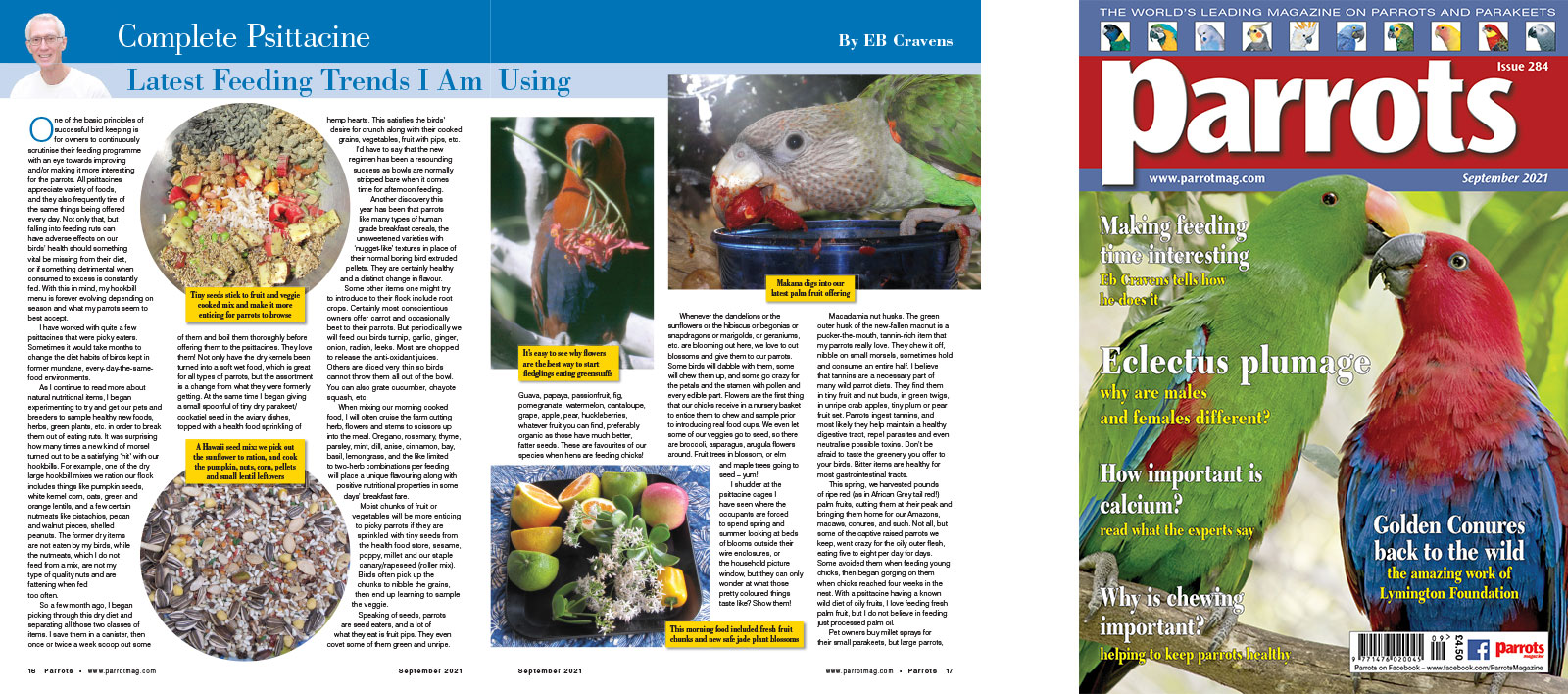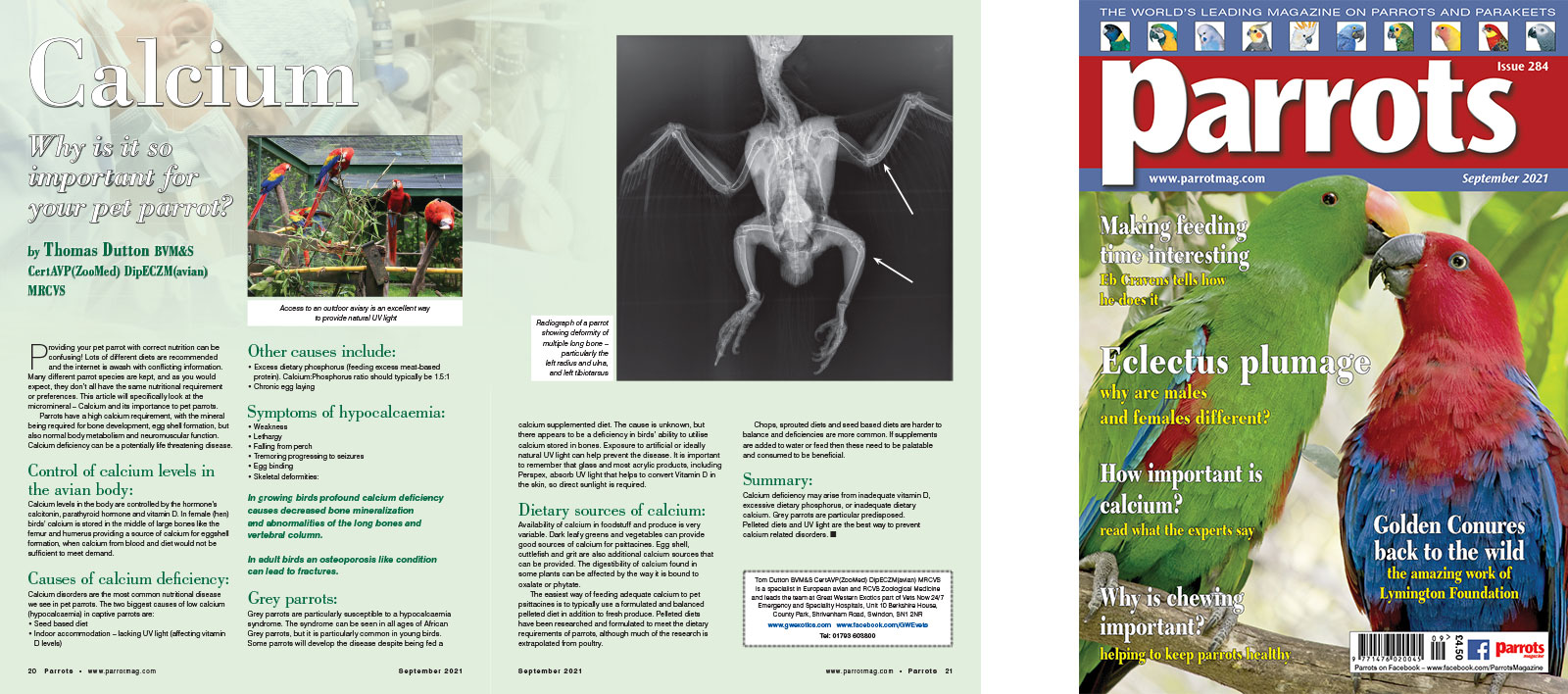
The Holistic Parrot by Leslie Moran
While researching how birds react to the colour red, and the significance of red in nature, I came across this landmark study on Eclectus parrots (Eclectus roratus) in the wild. Let’s explore what scientists Robert Heinsohn, Sarah Legge and John Endler discovered during their eight year research project in northern Australia. They offer unique insights into the attributes and behaviours that may explain the plumage colours of this unique parrot.
In contrast to the Eclectus, the females in open-nesting birds (such as some finches) need to have plumage colours that help them blend into the surrounding plants and foliage when incubating eggs in the nest. In contrast non-Eclectus females of hollow nesting psittacines often have plumage colours similar to the males of their species. These parrots have also been seen to share parental duties such as incubating the eggs, foraging for food and feeding the young. These activities expose the pair more equally to predators. Researchers Heinsohn, Legge and Endler speculate that in most avian species, their plumage colours are influenced by Darwin’s theory of natural selection. Whereas, Eclectus plumage colours have occurred because of other unique factors.
In non-psittacine species, some male birds typically possess brilliant plumage. Researchers surmise that this occurs so that the male is visually more enchanting when there are a limited number of females available for breeding. And when females in these species do have more brightly coloured plumage, this is seen exclusively where the birds demonstrate role reversing behaviours (identified as sex role reversal) during breeding. This means the males take on more traditional female roles and the females adopt activities that males commonly preform.
Buy Now!

Complete Psittacine by Eb Cravens
One of the basic principles of successful bird keeping is for owners to continuously scrutinise their feeding programme with an eye towards improving and/or making it more interesting for the parrots. All psittacines appreciate variety of foods, and they also frequently tire of the same things being offered every day. Not only that, but falling into feeding ruts can have adverse effects on our birds’ health should something vital be missing from their diet, or if something detrimental when consumed to excess is constantly fed. With this in mind, my hookbill menu is forever evolving depending on season and what my parrots seem to best accept.
I have worked with quite a few psittacines that were picky eaters. Sometimes it would take months to change the diet habits of birds kept in former mundane, every-day-the-same-food environments.
As I continue to read more about natural nutritional items, I began experimenting to try and get our pets and breeders to sample healthy new foods, herbs, green plants, etc. in order to break them out of eating ruts. It was surprising how many times a new kind of morsel turned out to be a satisfying ‘hit’ with our hookbills. For example, one of the dry large hookbill mixes we ration our flock includes things like pumpkin seeds, white kernel corn, oats, green and orange lentils, and a few certain nutmeats like pistachios, pecan and walnut pieces, shelled peanuts. The former dry items are not eaten by my birds, while the nutmeats, which I do not feed from a mix, are not my type of quality nuts and are fattening when fed too often.
Buy Now!

By Thomas Dutton BVM&S CertAVP(ZooMed) DipECZM(avian) MRCVS
Providing your pet parrot with correct nutrition can be confusing! Lots of different diets are recommended and the internet is awash with conflicting information. Many different parrot species are kept, and as you would expect, they don’t all have the same nutritional requirement or preferences. This article will specifically look at the micromineral – Calcium and its importance to pet parrots.
Parrots have a high calcium requirement, with the mineral being required for bone development, egg shell formation, but also normal body metabolism and neuromuscular function. Calcium deficiency can be a potentially life threatening disease.
Control of calcium levels in the avian body: Calcium levels in the body are controlled by the hormone’s calcitonin, parathyroid hormone and vitamin D. In female (hen) birds’ calcium is stored in the middle of large bones like the femur and humerus providing a source of calcium for eggshell formation, when calcium from blood and diet would not be sufficient to meet demand.
Buy Now!

By World Parrot Trust
As we know, wild parrots are very busy creatures, searching for and then dismantling foodstuffs in order to get at the choicest and healthiest morsels they need for survival. In their natural ranges, parrots ingest bark, leaves, and other debris, they also strip vegetation and chew wood to build nests. In certain parts of the world, parrots take clay soils to get minerals and to neutralise toxin from seeds they eat. So, instinctively parrots want to work for their living, they expect to.
Companion parrots have no such outlet for these wild tendencies, so boredom, and its attendant problems, can result. They often find themselves at the mercy of their human’s schedules, a certain time to eat, a specific time for a bath, and playtime.
If we, as their keepers, can replicate items found in the wild with puzzles, toys, preening items, and browse for them to keep busy with during our absence, then to some degree, these intelligent animals can be kept mentally and physically occupied. Keeping parrots busy with toys and browse, and closely supervising any out-of-cage excursions, will also distract them from chewing on household items that aren’t safe, like electrical cords and window blinds. Plus, a healthy parrot with no underlying issue and provided with safe chewing opportunities, should never need to have its beak trimmed.
Buy Now!




